
BRITISH, AUSTRALIAN, SOUTH AFRICAN, & NATO MILITARY TELEGRAPH KEYS:
FIELD TELEGRAPH SETS:
The British Army used a variety of field telegraph/telephone sets. Many of them were designed by A.C. Fuller in 1915. Named "Fullerphones", they made it impossible to intercept the telegraph signals (because they were DC) and then made them audible by using an interrupter and headphones.

WW-I Fullerphone:
This early set is mounted in a canvas-covered wooden box. It contains a telegraph key with a folding lever which allows the box to be closed. [704]

WW-II Fullerphone:
This British field telegraph set was usually mounted in a wooden box. [708]. On the right side you can see one of the familiar WW-II WT-8A keys (Properly called Key, WT 8 Amp). (See below:)




The "KEY, WT 8 AMP":
The WT-8A keys were made in over 100 versions in 6 countries and in huge quantities starting in the 1920’s. They were used by the British armed forces with most of their communications gear throughout WW-II. [710, 712, 714, 716]
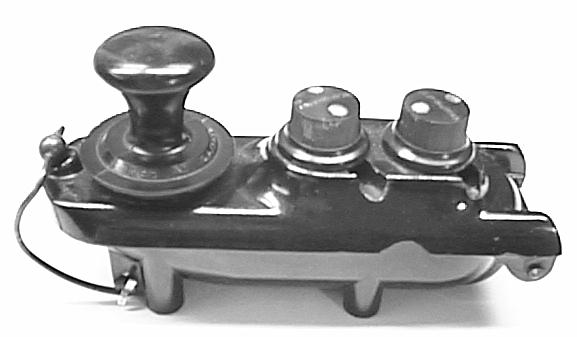

The British Air Force R.A.F. "Bathtub" Flameproof Key:
This interesting key was the standard key used in British bombers throughout WW-II. It is totally enclosed, making it suitable for use in explosive environments. The mechanism is attached to the top of the key and operates "upside down". The metal clip seen on the left keeps the cover closed but it can also be slipped over the skirt of the knob to hold it down and thus send out a continuous signal. This allowed a radio operator to parachute from a damaged plane while still sending out homing signals for rescue craft. These keys are common enough to allow most collectors to find one. [720]

WT-8A Strap-on-The-Leg Key:
WT-8A Key (Properly called: Key, WT 8 Amp) in a black sheet-metal box. Canvas straps held it to the radio operator’s leg. [721]
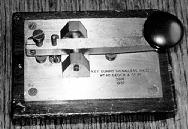
"Dummy Signaller’s" Key:
Versions of this lovely all brass key with no electrical connections were made from 1902 to 1939 (shown). It helped British Army Trainee Signallers become familiar with the sound of a telegraph key and sounder because it made a firm "click" when the lever was pressed, and another when it was released. [724]
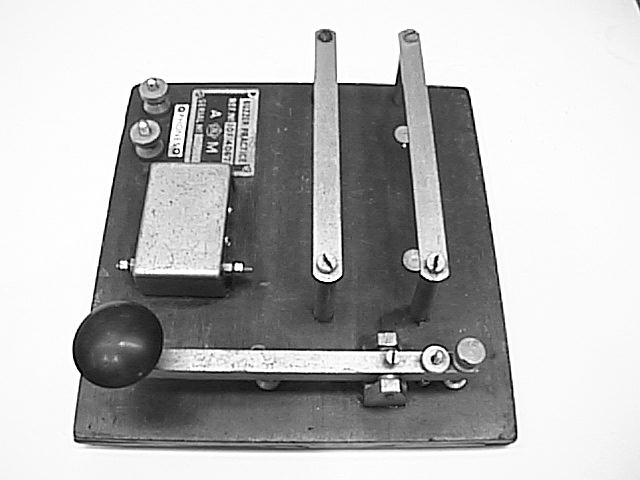
British Air Ministry Training Set:
These sets were used for training cadets to send and receive the Morse Code. They incorporated a classic European-style telegraph key with the typical straight, heavy, rectangular lever and the tension pull-down spring. The key was mounted on a wooden board along with a buzzer and a battery hold-down clamp. [726]

British Training Key:
This simple key was used by cadets in conjunction with a separate buzzer and battery for learning the code. It has a plastic base into which the letters of the code are molded. [728]

Key, Lightweight:
This tiny key was used on many post-WW-II British and Australian portable field radio sets. It is completely sealed and waterproof and has non adjustable contacts which require 10 oz. pressure and have .013" travel. [730]

"SPY" Keys:
These miniature military keys are often assumed to have come from clandestine spy radios used behind the enemy lines. [732]

Actually, the tiny keys such as this one [734] were used in military field telegraph/telephone sets
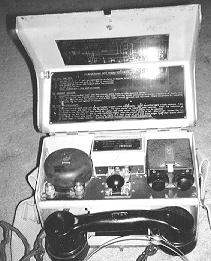
such as the one shown above. (Which often sell for less than the keys due to their size and weight.) [735]

Australian Field Radio Set Key:
This is a typical strap-on-the-leg key designed for use with portable field radio sets. It has a very unusual wide flat lever. It is stamped: Z1/ZAA 7990 Key, W/T (AUST) No. 1. [742]

South African and British KMK.2 Key:
This totally-enclosed flameproof key was used with British C11, C12, and C13 portable field radio sets. A version was made by SMD in Pretoria, S Africa. [744]

NATO Key:
This impressive key incorporates the classic Scandinavian long tapered lever. It was designed for use by NATO forces. [746]
NOTE:
(Please see the bibliography for Luis Meulstee’s comprehensive AWA article on many of these and other foreign military keys and also see the back issues of "Morsum Magnificat")
CANADIAN MILITARY TELEGRAPH KEYS:

Westclox Key:
This key is the Canadian version of the ubiquitous British WT-8A key (Properly called: KEY, WT 8 AMP). It was used in many of the Canadian field telegraph sets and radios. [754]
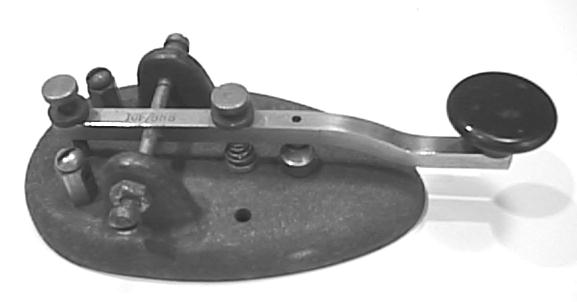
Grimmer-Wilson Key:
This key looks VERY much like the McElroy Stream Key: The lever is stamped 10F/556, and the name "Grimmer-Wilson" is cast into the underside of the grey wrinkle-finish base. [760]

Grimmer-Wilson Practice Set:
This set consists of a telegraph key with the same style of lever used in the Grimmer-Wilson key described above. The key is mounted on a black plastic base along with a buzzer and a battery holder bracket. The base is marked: No. 10A/726. Made by Grimmer-Wilson, Toronto, Ontario, Canada. [764]

Military Aircraft Light Blinker Key:
This round, vertically-mounted flameproof key was made in bakelite and metal versions. It was used to blink the top and bottom lights on many of the RAF and Canadian Air Force airplanes for visual plane-to-plane and plane-to-ground communications during periods when "radio silence" was being observed to keep the enemy from listening in. [770] All pilots were required to learn the Morse Code to a speed of 15 words per minute.
GERMAN MILITARY KEYS:

Early German Arc Transmitter Key Recovered from a Sunken WW-I Cruiser:
This interesting key was brought up by divers from a sunken German Cruiser in Scappa Flow. Pushing the entire key down activates the transmitter. [802] (Museum of Communication, Scotland)

Early WW-I German Radio Key:
This key has the characteristic normally-open and normally-closed contacts. The lower contacts are mounted on springs to add a wiping action as the contacts close. [806] (Pete Malvasi - W2PM)

Junker WW-II Key:
These keys have very precise adjustments and a very crisp feel. [810] They were, and are still made by the Junker Co., of Bonn - Not to be confused with Junkers who made planes.
NOTE: WW-II Keys with the nazi eagle-and-swastika stamp are generally worth about 30% more than without. Look closely, it’s a very small mark stamped into the plastic. The DRP (Deutsches Reichs Patent) mark also indicates WW-II. (DBGM indicates post-war manufacture)
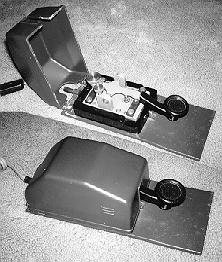
Recent Junker Keys:
Junker continues to manufacture these keys and they are still available. This is one of the current models. Colors are olive drab or silver. [812]

Junker Clip-on-the-Leg key and Allied Copy of the Junker Design:
The Germans manufactured a leg clip for their Junker keys which allowed the keys to be secured to the radio operator’s leg in aircraft and ground vehicles. [814] The Allied copy with a J-37 key mounted on the clip is also shown (at the top).
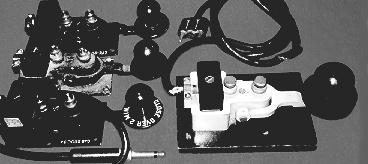
Luftwaffe Flameproof Key which was Copied by the Allied Forces and Became the Cxx-26003A WW-II U. S. Navy key.
On the right is the original German key with the "BAL" Luftwaffe markings [818] and on the left are several examples of the classic Allied forces WW-II Navy key. [660]

Maus Keys:
The tiny German Maus keys were used with many WW-II German field radios. They were made in several versions. The smaller version [820] has half of the knob cut.

Larger version of the German Maus Key [821] has a full-round knob.

T-1 Baumuster Key:
The Baumuster keys were very widely used with German radio sets. They were also called "T-1" , "Taste (key) P", or Taste "Paula". [824]
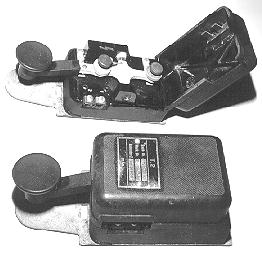
T-2 Key: (above): The T-2 was another widely used radio key. [826]
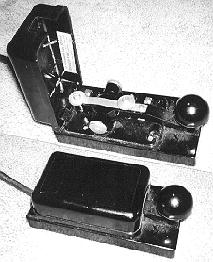
K-34: Another German radio key: [828]
JAPANESE MILITARY RADIO KEYS:

Early Japanese Radio Key:
This is a nicely made key mounted on a wooden base with a "classic" European- style straight lever and a cover. The label gives information about when the key was made relative to a particular emperor and thus dates the key. [860]

Miniature Japanese Key:
This tiny key was brought back from the island of Mindanao after WW-II. It had been used in the back seat of a command car. [864] It is shown next to a quarter for size comparison.

Japanese Navy Key:
This key and the box in which it was mounted were removed from a destroyer anchored in Tokyo Harbor on the day of the Japanese surrender. It has the spring-mounted lower contacts that are characteristic of ‘German’ military keys. [870] Without this history or "provenance", it would be worth less. [870a]

Miniature WW-II Japanese "Zero" Aircraft Key:
This small key was mounted in the cockpit of a WW-II Japanese Zero fighter aircraft. [874]
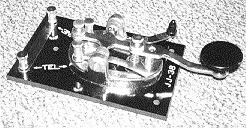
Recent JJ-38: Japanese Copy of the U.S. J-38 Telegraph Key:
This key is a copy of the design of the U.S. J-38 key. It uses the extremely common Japanese ball-bearing copy of the Triumph key, mounted on a black plastic copy of a J-38 base.[ 896] (Not really a military key)

Recent Chinese Radio Key:
These nicely made keys are beginning to show up in small quantities in the U.S. [898] (Not a Military Key)
RUSSIAN AND CZECH KEYS:

Plastic-Enclosed Russian Military Keys:
These keys were manufactured with and without a spark suppressing capacitor in the base. [910]
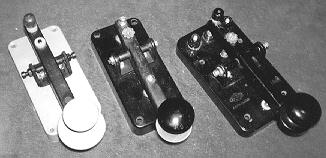
Plastic-Based Russian Military Training Keys:
These keys were made in a number of styles. They are of very simple design and show the influence of the classic European-style straight lever. [ 912]

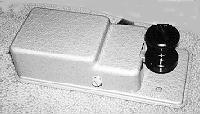

Metal Enclosed Russian Military Keys:
The tiny one on the right [920] and the one in the middle [922] were used with the R104M radio sets. The one on the left was used with the high-powered R102M radio sets. [924]

Russian Flameproof Key:
This key is completely sealed in a (non-waterproof) plastic housing. Its internal mechanical design is very similar to the German Junker keys but it does not have the same kind of fine micrometer-like adjustments. [926]

Czech Army Key:
This interesting and unusual key is enclosed in a plastic casing. When the knob and associated lever of the key is raised slightly upward (as shown), the contacts are shorted out. [946]
NOTE: See Luis Meulstee’s excellent AWA article on these and other unusual military keys listed in the bibliography. Also see issues of Morsum Magnificat.
HOMEMADE KEYS:
Over the years, thousands of people have tried their hands at making their own keys. They were motivated either by an attempt to save money or by a belief that they could come up with a better design. Some of the designs are interesting and innovative but, unfortunately, most collectors avoid buying and owning even the most interesting of these designs. I hope that as more people become involved in collecting telegraph keys, innovative homemade keys will become more widely appreciated.

The BASIC Homemade Telegraph Set:
Probably the most frequently built telegraph set is the basic Key and Sounder. Kids often build them as science projects, scout projects, and just for fun. This is perhaps the simplest design. It uses just nails, strips of metal, and wire. It’s construction is described in detail in my museum. http://w1tp.com [954]

Another Simple Key and Sounder Design: This set was built from plans in a popular children’s periodical from the 1930’s [956]
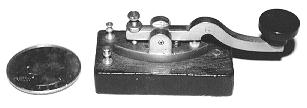
A Beautifully-Homemade Miniature Camelback Key: [958] This key was made by a very well known telegraph key collector.

A Tiny, Dime-Size Hand Key: Made in Roumania: [959]

A Very Nicely Made Full-Size Hand Key: [960]

A Paddle With Really Terrible "Feel":[962]

A Homemade Semi-Automatic Bug Designed to be the Knob of a Straight Key:
This is the strangest bug I have ever seen. The designer of this tiny, and unusual bug has made it fit over the knob of a straight key. Flipping the bug's support legs up allows it to be used as the knob of the straight key. [ 968]
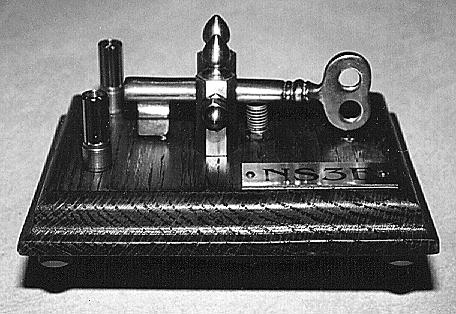
Homemade "KEY" Key:
This unusual and amusing key key was made by collector Ed Biter - NS3E. [969] It is part of his permanent collection.
UNUSUAL NOVELTY ITEMS:

"Stapler" Made in the Shape of a Polechanger Key:
This is a fully-functional stapler which closely resembles a Spies Polechanger key. (See item 120) The line-selecting switch acts as a staple remover. Many of these were sold. [970]
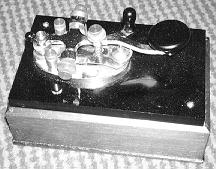
Cigarette Lighter Made in the Shape of a Bunnell Triumph Key:
This is a fully-functional cigarette lighter with a butane reservoir and batteries in the base. Pressing down on the lever releases the butane and activates a buzzer which makes a spark to light the butane, and can also be used for code practice. Quite a few of these were sold. They were made by the Hugo Rousseau Co. [971]

Transistor Radio and Code Practice Oscillator Made in the Shape of a KOB:
This set consists of a fully functional AM transistor radio. In addition to serving as a radio, when the key lever is depressed, it emits a tone which can be used for code practice. [972]